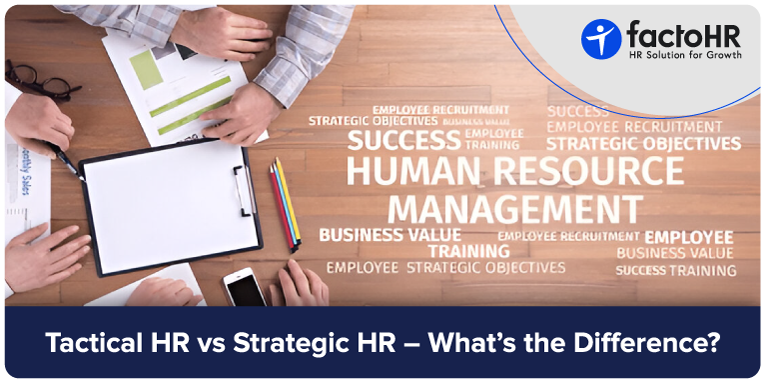Tactical HR vs Strategic HR – What’s the Difference?

Table of Contents
Many businesses today are experiencing rapid growth and require scalable human resources (HR) support. HR teams must focus on both daily work and long-term planning. Tactical HR and strategic HR both have important roles. Both help build a successful company.
Tactical HR handles everyday tasks. It includes hiring, training staff, keeping records, and handling leave requests. It also makes sure company rules and labor laws are followed. These tasks may seem small, but they are key to keeping the business running well.
Strategic HR is more focused on long-term goals for the company and employees. It includes workforce planning, improving employee performance, and building company culture. Strategic HR aids in guiding the business toward sustainable growth over time.
The difference is clear: tactical HR addresses current needs, while strategic HR anticipates future needs. A strong HR team strikes a balance between these two to ensure both immediate efficiency and long-term success. Without this balance, a company may either miss future opportunities or struggle with current demands.
Understanding this distinction helps businesses build resilience, adapt to change, and grow effectively.

What is the Role of Tactical HR?
Tactical HR focuses on daily HR tasks that keep operations running smoothly. It supports short-term goals through hiring, training, compliance, and employee management.
Recruitment and Hiring
Tactical HR manages job postings, shortlisting, interviews, and onboarding. It helps fill roles quickly and ensures the team has the necessary personnel to operate smoothly.
Employee Relations
Tactical human resources handles workplace issues and encourages healthy communication. It supports employee relations as part of the HR plan to maintain a positive work environment.
Training and Development
Tactical HR arranges programs to improve employee skills and prepare them for their roles. It supports training and development through planning to boost performance.
Compliance
Tactical human resources ensure that the company adheres to all applicable laws and policies. Maintaining HR compliance ensures a safe and fair workplace for all.
HR Policies and Procedures
Tactical HR creates, updates, and implements policies for daily operations. This work, guided by tactical HR planning, helps maintain clarity, fairness, and smooth workflow.

What is the Role of Strategic HR?
Strategic HR looks at long-term goals to help the business grow. It connects people’s work with the company’s vision to achieve success.
Talent Management
Strategic human resource management helps attract and grow the right people. It focuses on talent management to build a strong and skilled workforce.
Workforce Planning
Strategic HR planning encompasses workforce planning to anticipate future hiring needs. It helps the company always have the right people in the right jobs.
Performance Management
Strategic HR focuses on setting clear goals and supporting employee growth. It uses performance management to track progress and improve results over time.
HR Analytics
Strategic human resource management uses HR analytics to guide decisions about employees. It relies on real data to drive informed and effective decision-making.

What are the Main Differences Between Tactical HR vs Strategic HR?
Effective workforce management relies on human resource planning to align daily HR tasks with long-term goals. It bridges tactical HR and strategic HR to support overall business success. It helps businesses prepare for the future while managing daily challenges. Using both well leads to better employee satisfaction and business results.
Understanding the difference between tactical and strategic HR is essential for developing a robust workforce. Both are essential for creating a flexible and successful team. Together, they help a business grow and succeed over time.
Why the Best HR Leaders Use both Strategies?
The top HR leaders understand the importance of striking a balance between tactical HR and strategic HR. They understand that real success comes from managing everyday tasks with long-term goals. Good HR leadership means combining strong execution with a clear vision. This balance helps companies stay flexible and grow steadily.
Tactical HR focuses on everyday tasks, such as recruitment, training, and employee relations. Strategic HR focuses on planning future workforce needs and managing talent. Leaders use both approaches to handle today’s work and prepare for tomorrow. By using both, HR leaders create a caring workplace where people feel valued. Tactical HR helps solve issues quickly and keeps daily operations on track.
Strong HR leaders listen, adjust, and shape plans based on results and evolving business needs. This flexibility supports both growth and employee well-being. Combining tactical and strategic HR brings direction and resilience.
When leaders apply both strategies, teams stay focused and aligned. This approach promotes continuous improvement and keeps long-term goals in sight. It also encourages collaboration and innovation, strengthening the entire company.
The best HR leaders know how to balance short-term action with long-term planning. They address today’s needs while preparing for future challenges. This mindset builds strong teams and a forward-ready workplace.

Conclusion
A balanced HR approach combines both tactical HR and strategic HR to support business success. Tactical human resources focus on daily operations, such as hiring, payroll, and enforcing company policies. These activities keep the organization running smoothly and ensure employee needs are met.
Strategic human resource management focuses on long-term planning, aligning talent and development with company goals. It helps build a workforce that’s ready to meet future challenges and drive growth.
Focusing too much on one side creates gaps. Without strategic planning, growth may stall; without strong tactical support, daily operations suffer. The best HR leaders blend both approaches thoughtfully, solving today’s problems while building tomorrow’s team.
This balance earns trust from both employees and leadership. Tactical HR focuses on building consistency and compliance, while strategic HR drives innovation and progress. Together, they shape an efficient, supportive, and future-ready workplace. When used well, this dual approach strengthens company culture and aligns HR efforts with business success.
Grow your business with factoHR today
Focus on the significant decision-making tasks, transfer all your common repetitive HR tasks to factoHR and see the things falling into their place.

© 2025 Copyright factoHR


